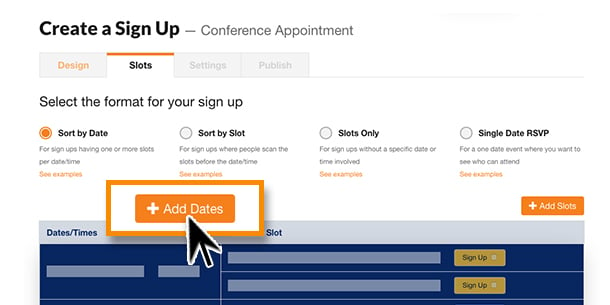Zoom Appointment Slots
Despite increased on-campus COVID cases and nagging concerns of a slow and unpredictable vaccine rollout, many professors have been itching to get back into the classroom.
- Connect all of your various calendars so AppointmentThing can check when you’re available and avoid offering appointment slots during times when you already have something scheduled. This also allows scheduled appointments to be added automatically to the calendar of your choice.
- Your instructor can offer one-on-one private appointments to all students in the course. Navigate to 'ConferZoom' on the left menu. Select the 'Appointment Booking' tab 3. Select your instructor for your course in the drop-down menu. View available slots in the instructor's calendar, and request to schedule an online appointment.
- To List Your Appointments To Use Zoom With Appointment Slots Step-by-step guide. Log into your Google account in a browser and go to your Google Calendar. Click a date to set up appointments for, or click the +Create button in the top left corner. Select Appointment Slots just below the Title field.
Open Google Calendar and click on a Zoom meeting you’ve scheduled. Hover over a join option and click the icon to copy the information or click Join Zoom Meeting to open Zoom and join the meeting.
Taking students’ support and gratitude for in-person learning last semester as motivation to return to campus, many have felt more empowered to teach in physical classrooms, citing fall success and clear benefits.
“I just realized last semester how much the students were really missing the in-person contact,” explained Prof. E. Lauren Chambliss, communications. “From the very first class [this time around], every single student joined in the conversation.”
Prof. John Blume, law, who is teaching two hybrid courses this semester — one for undergraduate students and the other for law students — also felt inspired by student support for in-person learning.
“[Students] want to thank you for letting them go back to the classroom and have an in-person experience, so I think that’s been good and rewarding,” Blume said.
After spending most of 2020 behind their computer screens, many professors said they felt more comfortable and safer returning to teach in person.
Leaderboard 2

“I was really heartened by my colleagues who were brave enough to give [in-person instruction] a try in the fall,” explained Chambliss. “When I talked to them, they just [said] they never felt unsafe and the students all seemed to appreciate being there.”
Between Cornell’s robust testing program and the total absence of classroom transmission cases in the fall, the benefit seemed to outweigh the risk.
“I would have taught in person last semester, actually. I did not have a concern,” said Prof. Drew Margolin, communications. “It’s about Cornell having a good plan, which I think they had. They’re testing people all the time, I don’t know how much more you can do than that.”
Newsletter Signup
Professors who agreed last semester to teach in-person this semester did so prior to New York State adding in-person college professors to phase 1b of vaccine distribution on Jan. 11. Now, though, they’re starting to be vaccinated.
Chambliss, who already received her first dose of the vaccine, said she was grateful to state health officials, who made the decision to expand the eligibility requirements: “It was an enormous bonus to teaching in person that I didn’t really expect.”
Still, like much of the last year, vaccine distribution has not gone according to plan for some professors — many faced hiccups like far-off appointment slots and technological problems while booking. Margolin, who recently received an appointment in Syracuse next month for his first shot, found rollout to be chaotic.
“While these issues are coming from the state and federal level, it’s still not efficient or equitable,” he explained. “If you’re really savvy about online interfaces, then this is great for you, but it’s really not the equitable way.” Others nationwide have cited access issues about needing an email address, for example, to get a vaccination appointment.
While the obstacles to online teaching last semester have made professors eager to get back to in-person classes, teaching in-person and hybrid courses has introduced a different set of concerns.
“Under my mask I’m making facial expressions, but I don’t know what [students] see,” explained Margolin. “I haven’t quite figured out how to emote and get the students to loosen up. It feels very stiff. I’m trying to figure out a way to make it more familiar without seeing each other.”


Other concerns include students who rely on lip-reading to understand material and the general challenges to working in small groups while distanced.
Blume, who is teaching a hybrid class of 120 students, only some of whom are in person, has found new ways to actively involve everyone in class discussions, even if they aren’t in the classroom, using virtual tools.
“I don’t want to feel as if they’re getting a lesser experience than the students that are in person,” he explained. “I’ve used more polling and questionnaires. … I think I’ll continue to do that even if things return to whatever they return to next semester.”
Chambliss said she plans to incorporate more Canvas discussions into her classes: “If we do some of it online first, and then we digest it even further in the classroom, we get to go one step deeper.”
Despite these challenges of only visible tops of faces and technical difficulties to be heard over Zoom, many professors are excited to just see their students in person again.
Google calendar comes with Google suite for your domain and it offers many powerful features to keep you organised. It can do so much for you with just a few clicks.
Learn how to schedule appointment slots using Google Calendar. So, let’s say you offer a service and you want potential customers to book an exploratory call with you or maybe schedule a time to meet with you. You can create appointment slots on your calendar, make it available on your website and just like that, people know when you’re available without having to call you first.
If you’re not already using Google Calendar see how to get started here: Take control of your Schedule like a Boss with Google Calendar
Consultant with limited hours to book meetings, or want to limit the times your team can book time with you to certain times of day? Use Google Calendar to setup appointment slots. Click To TweetSo how does it work?
Open Google Calendar and in your calendar grid, click an empty time slot and click Appointment slots.
How To Book A Slot On Zoom
Create an Appointment slot in Calendar
Add a title and choose a date and time
(Optional) If you want to create your appointment slot on another calendar, at the bottom next to your name, click the Down arrow arrow_drop_down and select the calendar.
Select slots_with_duration and the duration of each appointment.
To create a recurring appointment slot, click More options and select the frequency.
Click SAVE.
Zoom Appointment Slots App
Your appointment block shows as a single event on your calendar, with a grid symbol in the top-left corner. As people book appointments, they’ll appear as regular events overlapping the appointment block.
Sharing your Calendar for Appointment booking
To share your calendar, click on an appointment slot and select Options, click on Publish event from the drop down menu.

You can now copy a shareable link or the html code to embed the calendar on your website.
Your users will now be able to add an appointment directly into yours and their Google Calendars. To cancel the appointment, all they have to do is delete the appointment on their Calendar and it will be deleted in yours too.
Make sure to switch on your notifications for your calendar so you’ll know every time someone books one of your appointment slots.